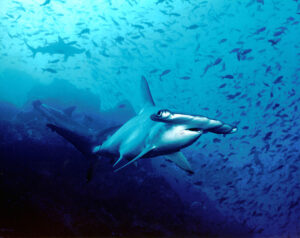
Logan, R. K., Vaudo, J. J., Sousa, L. L., Sampson, M., Wetherbee, B. M., & Shivji, M. S. (2020). Seasonal Movements and Habitat Use of Juvenile Smooth Hammerhead Sharks in the Western North Atlantic Ocean and Significance for Management. Frontiers in Marine Science, 7, 731. doi:10.3389/fmars.2020.566364
Best way to rebound?
Sharks may be apex predators of the seas, but even their formidable strength and speed underwater haven’t been a match for the juggernaut formed of global fishing fleets. Between ghost nets, bycatch, and purposeful fishing, many shark populations have dwindled over the last half-century. These creatures take a longer time to reach maturity and have pups of their own. Combine that with their influence controlling food webs from the top down and this loss is very concerning.
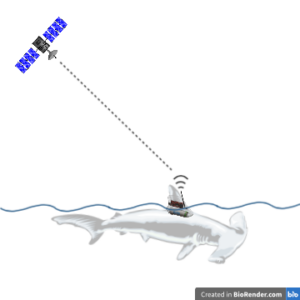
The hammerhead family of sharks, in particular, has been sought after and many are now endangered. Protecting them while they’re young is important to help them bounce back. The best approach is to establish protected areas or spaces where fishing pressure is small for a certain part of the year. We have to understand where they travel, stay, and hunt to find where protection efforts will help the most. The bad news? The data we do have is sparse—lots of holes and open questions.
These are prime conditions, though, for researchers. A team of scientists headed by Ryan Logan from Nova Southeastern University in Florida set out to find smooth hammerheads that could provide some answers to these mysteries.
What secrets are those toothy smiles keeping?
Over days of longlining off the coast of Maryland, Logan and his crew caught six young, female smooth hammerheads and put satellite tags onto their dorsal fins. These tags would ping an overhead satellite whenever the shark’s fin broke the surface of the water, sending information about the animal’s position to researchers on the mainland. (Fig. 1) Depending on how often the shark surfaced, Logan was able to collect GPS coordinates from these teenage hammerheads for two to fifteen months. Entering the coordinates into a model allowed the team to estimate the sharks’ tracks during time away from the surface. Comparing the locations with data on water temperatures and water depths could then help in figuring out which areas might be best to protect.
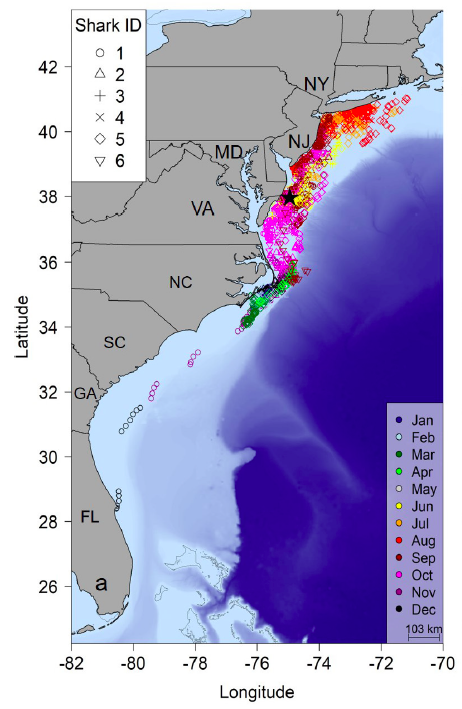
Pretty soon, a clearer picture came to light: these juveniles all migrated to and set up short-term shop in similar areas during different times of the year. Late spring and early summer meant hanging around off New York’s Long Island; shallow waters off New Jersey, Delaware, and Maryland played temporary hosts as the girls swam further south. Autumn was a time of travel, and it wasn’t until the winter and spring months that the hammerheads settled in, escaping cooler waters and hanging around south of the Carolinas. (Fig. 2)
What a coincidence!
As it so happened, a protected area off the coast of North Carolina had already been established in 2005 after data showed a different species (dusky sharks) had a preference for those waters. While fishing could still take place in the area, longlining specifically is banned for seven months of the year. While it’s an effective means of catching sharks for research purposes, long-lining can be deadly if the fishing gear is left out for too long. Most sharks need to swim through large amounts of water to get enough oxygen over their gills; hooked on these lines, their movement is limited and they often suffocate if they’re not cut loose. Luckily, the ban each year overlaps with the time dusky sharks reside in the area—and they might not be the only sharks benefiting.
Turns out, four of the tagged hammerheads also took advantage of these warmer waters. (Fig. 3) However, they appeared in the protected area a bit ahead of the schedule set by the dusky sharks. While they are shielded from long-lining for some of the year, they still have a chance of being snagged in early winter before the ban comes into effect. Something is better than nothing, though, and while more satellite data would be helpful (for example, could males and females have different travel patterns or favorite hangout spots?), this study is exciting since it’s provided a glimpse at a vulnerable predator’s early life history. It may mean more regulation in the future but if nature’s complexity hasn’t made it clear already, solutions to these problems will come in a patchwork of efforts, spread out over space and time—just like these rowdy hammerheads!
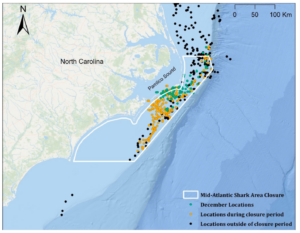
I am a former PhD student from the University of Rhode Island, having discovered my love of teaching and informal science education in part through OceanBites! Since departing academia, I’ve focused on creating educational content for visitors at the New England Aquarium, Chincoteague Bay Field Station, and now the National Aquarium. I’ve also dabbled in co-creating a comedy/brainstorming podcast, ThunkTink, and enjoy getting lost in nature with my dogs.

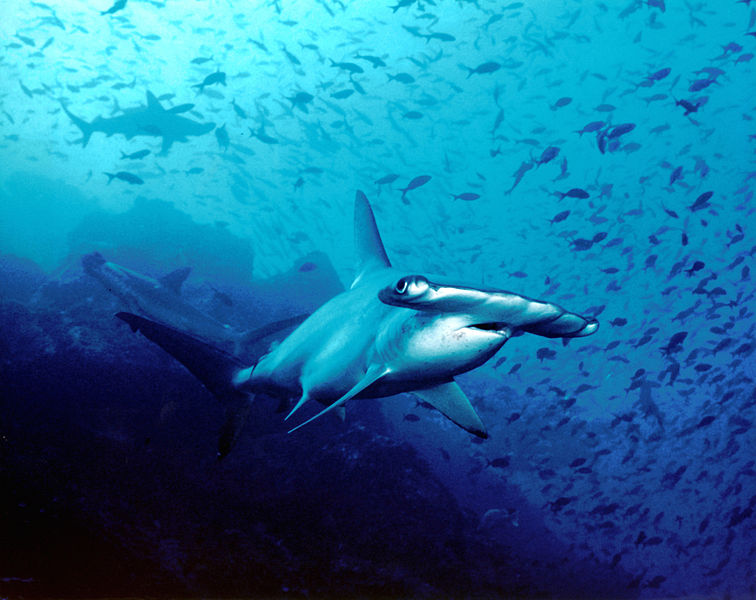

Thanks for covering this research, it’s a well written description.